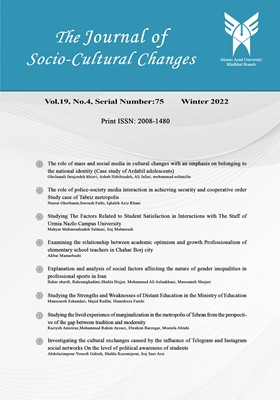The role of mass and social media in cultural changes with an emphasis on belonging to the national identity (Case study of Ardabil adolescents)
Subject Areas : Media
GHOLAMALI FARAJZADEH KHIAVI
1
![]() ,
ashab habibzadeh
2
,
ali jafari
3
,
Mohammad Soltanifar
4
,
ashab habibzadeh
2
,
ali jafari
3
,
Mohammad Soltanifar
4
1 - Ph.D Student of Communication Science, Ardabil Branch, Islamic Azad University, Ardabil, Iran
2 - Associate Professor, Department of Social Sciences, Amin University of Law Enforcement Sciences, Tehran, Iran.
3 - Associate Professor, Department of Communication Sciences, Ardabil Branch, Islamic Azad University, Ardabil, Iran.
4 - Department of Communication Sciences / Science and Research Branch / Islamic Azad
Keywords: Mass Media, social media, sense of belonging, National Identity, Cultural changes,
Abstract :
The purpose of this research was to compare the role of mass and social media in cultural changes with an emphasis on belonging to the national identity of teenagers. The research method was causal-comparative. The statistical population of the research consists of all adolescents (13-17 years old) of Ardabil city, numbering 50,000, of which 380 people were selected as a sample by cluster random sampling. To collect data, a researcher-made questionnaire for the media and a standard questionnaire by Selgi et al. (2014) were used for the feeling of belonging to the national identity. Cronbach's alpha coefficient was used to estimate the form and content validity of the questionnaires from the experts' and professors' point of view, and the Cronbach's alpha coefficient was used to estimate the reliability of the questionnaires, which was higher than 0.7 for the questionnaires. Data were analyzed through t-test and multivariate analysis of variance (MANOVA) in SPSS software. The results showed that mass and social media play a different role in the feeling of belonging to the national identity and its dimensions (social, historical, cultural and political) among teenagers (P<0.01). So that the feeling of belonging to the national identity and its dimensions among the teenagers whose media consumption is of a social type is less than the teenagers who are of a collective type. 5.7% of cultural belonging, 7.7% of historical belonging, 9.7% of political belonging and 14.7% of social belonging of teenagers are explained through the difference in the effect of the type of media (collective and social). Therefore, it is concluded that the type of media plays an important role in the cultural changes of teenagers in general and the feeling of belonging to the national identity in particular.
_||_


